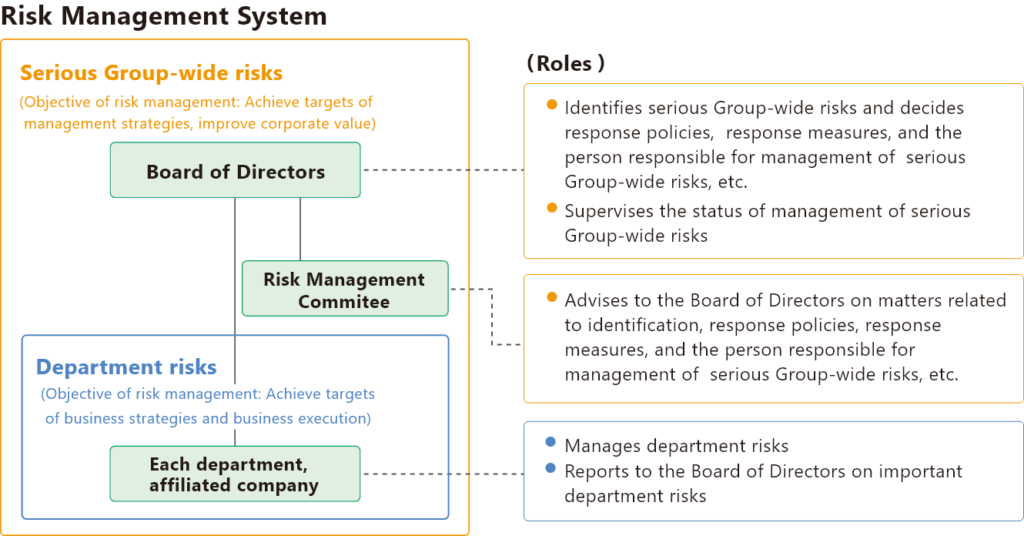Risk Management
We are implementing a variety of measures to accurately identify and respond to risks that accompany changes in management and business environments and that could impact the long-term continuation of Nippon Shokubai Group, in accordance with our Risk Management Regulations.
Risk Management System
At our Group, we classify various internal and external risks that threaten our Group into “serious Group-wide risks” and “department risks,” and we develop a risk management system appropriate for each risk category, thereby maintaining and improving our corporate value.
For “serious Group-wide risks”, potential serious risks underlying execution of the Group’s management strategies, sustainable improvement of corporate value, and acquisition of trust from stakeholders are subject to risk management, and we have established a risk management system based on “serious Group-wide risks” management process.
For “department risks,” on the other hand, potential risks underlying execution of business strategies or business operations by each department or affiliated company are subject to management, and we have established a system in which each department or affiliated company is responsible for risk management, thereby promptly responding to the risks.
With these two systems, we aim to develop and enhance the Group-wide risk management system, which includes our affiliated companies.

Risk Management Committee
The Risk Management Committee, as an advisory body to the Board of Directors, is composed of the members listed in the table below.
| Chairperson | President |
| Member | Inside Directors of the Board, Executive Officers and others appointed by the President |
| Secretariat | General Affair & HR Division |
| Observer | Inside Audit & Supervisory Board Members |
“Serious Group-wide risks” management process
1: The Risk Management Committee evaluates the proposed “serious Group-wide risks” candidates based on their impact (such as financial impact) and probability of occurrence. The committee then identifies the “serious Group-wide risks” and appoints the management responsible and submits a report to the Board of Directors. The Board of Directors decides on the “serious Group-wide risks” and the person responsible for management based on the report.
2: The person responsible for management reviews the response policies and measures and submits them to the Risk Management Committee. The Risk Management Committee verifies the validity of the submitted content and reports to the Board of Directors. The Board of Directors decides on the response policies and measures based on the report.
3: The person responsible for management conducts risk management and reports the management status to the Board of Directors at least once a year. The Board of Directors supervises this process.
4: The Risk Management Committee holds meetings as needed to assess changes in the external environment and determine the necessity of responses, reports the results to the Board of Directors.
“Serious Group-wide risks” and the response measures
Risk Related to Large-Scale Disasters
Risk Overview:
Significant impact on business continuity due to damage or loss of function at various sites or across a wide area caused by a large-scale earthquake.
Response measures:
•Consideration of the need for additional seismic reinforcement of buildings and facilities at each business site and group company.
•BCM (Business Continuity Management), etc.
Risk Related to Cyber Attacks
Risk Overview:
Significant impact on business continuity due to the suspension of core systems or leakage of important information caused by cyber attacks.
Response measures:
•Conducting network vulnerability assessment.
•Performing information security audit.
•Improving issues pointed out in assessments and audit.
•Acquiring and monitoring access logs, etc.
Risk Related to Conflicts
Risk Overview:
Significant impact on business continuity due to the occurrence of conflicts in regions that critically affect business operations, leading to a disruption in trade.
Response measures:
•Securing inventory of raw materials and promoting procurement from multiple regions.
Business Continuity Management (BCM)
We have established a Business Continuity Plan (BCP) with countermeasures for earthquakes, influenza outbreaks and other incidents. We are working to strengthen Business Continuity Management (BCM) by regularly reviewing our BCP, as well as by implementing earthquake response training and other measures.
Most recently, we revised the BCP in line with the improvement of IT tools and workplace environment. We are working to strengthen our crisis management system for large-scale earthquakes by making employees fully aware of the revised countermeasures through e-learning and conducting periodic training.